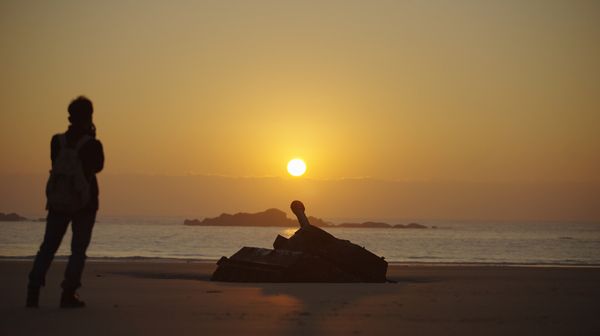Eye For Film >> Movies >> Island In Between (2023) Film Review
Island In Between
Reviewed by: Jennie Kermode

Strictly speaking, the name Kinmen applies to a group of islands, but also to the largest in that group, from which director S Leo Chiang hails. It’s best, in this case, to keep things simple, because Chiang’s identity is already complex enough. As he notes early on in this Oscar-shortlisted short documentary, people used to be afraid of being sent to Kinmen. Though it officially belongs to Taiwan, it’s just 10km from mainland China, with which, historically, it has been in more frequent contact. In the 20th Century it found itself on the front line; and more recently, it was reconnected, with a ferry carrying travellers to and from the supposed enemy land. As its people, however, and they will generally say that neither Taiwanese not Chinese identities quite fit them; they belong to the island in between.
In a world wedded to political absolutes, and never more so than between Communist countries and those allied with the US, this is an uncomfortable position. It may also be a uniquely sane one. Certainly, when considered over time, it offers an unusual perspective on the mechanisms of the lingering ideological conflict. Liang explores that perspective here, in a very personal way, re-examining experiences which, as he lived through them, he initially took for granted.
This is not a film for people wedded too closely to ideological perspectives of their own; at least not nationalistic ones. Having also spent a good part of his life in the US, Liang describes himself as feeling like the child of a three way divorce, tugged between countries which want to possess him and define his identity but which have little interest in his perspective. This is his opportunity to respond – and to do so before an international audience, at that. It’s also an opportunity to remind people in the US-ally grouping that we are subject to propaganda just as the other side is.
Liang grew up with constant messages about how awful China was, and about how Taiwan was the home of the true Chinese people who would one day invade their larger neighbour and free the people there (who outnumber them 60 to one). It’s a sentiment which made less and less sense in a nation where young people increasingly identified with English-speaking nations; more recently, the big pull has been from China itself, seen as a land of economic opportunity. Liang doesn’t go into depth on that – nor does he address the interesting linguistic issues at play – but he does explore the difference between the China he had been taught to imagine, full of hardship and misery, and the one he found, full of great shopping opportunities and entertainment. Perhaps there should have been a clue in that skyline seen from across the water, its skyscrapers towering over the charmingly old fashioned houses and public buildings of Kinmen.
Latterly, due to Covid, the island’s relationship with China has changed yet again, making for an interesting postscript. What really makes this film appealing, however, is the way in which Liang weaves together the personal and the political, reminding us that no matter the stories which those in power like to tell, on either side, they are meaningless in the face of actual human interconnection. To be from a place in between is to function as a point of connection, and although this may make Kinmen vulnerable, it also bequeaths it a magical quality which Liang’s film captures in its final shot full of water and sky and light.
Reviewed on: 24 Dec 2023
















